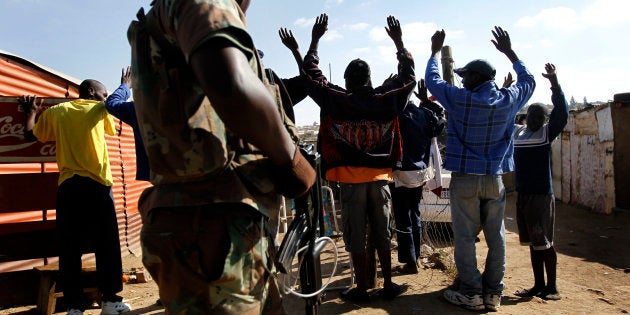
The International Organization for Migration (IOM) in partnership with the Department of Home Affairs ran an essay and multimedia competition on the topic: "How have migrants contributed to our communities, country and continent". As part of this initiative, the Department launched the Mkhaya Migrants Awards on 10 May 2015 to further promote the building of a united, democratic and prosperous society where citizens, residents and migrants live together in peace and harmony. Calls for essay submissions were made and my essay was selected as one of the ten winning essays. Below is the essay:
How do nations form an inclusive national identity in the growingly urbanised areas across the world? It is known that the majority of the world's population now lives in cities. The social, cultural and economic challenges that are generated by this growing concentration of population have now become symbolic of modern human life condition. This growth brings along with it large migration of individuals coming from diverse backgrounds which, thus, result in new forms of cultural cohesion that need to emerge.
The concept of cosmopolitan is derived from the Greek word kosmopolitês, which, when translated to English, means ''citizen of the world''. The Stanford Encyclopedia of Philosophy notes that "the nebulous core shared by all cosmopolitan views is the idea that all human beings, regardless of their political affiliation, are (or can and should be) citizens in a single community" (Kleingeld 2002).[1]
Michael Keith (2005), in his book, questions the efforts that are made to generalize from the experiences of migrant minorities in the increasingly multicultural cities of the world. He makes an attempt to suggest a different understanding of "the purpose of both theoretical labour and empirical investigation, whilst valorising the significance of both analytical debate and extended empirical engagement with the perplexing and contradictory realities of contemporary multicultural urbanism".[2]
At the dawn of the democratic dispensation in South Africa, disgruntled youth of the Alexandra township took to the streets armed with weapons, and destroyed the homes and shelters of suspected undocumented migrants. They forced these individuals to the police station where they demanded the migrants be repatriated back to their places of origin with immediate effect. Just 22 years later, the dusty streets of Isipingo in rural KwaZulu Natal encountered similar incidents to those which took place in December 1994.
Fast forwarding to 2015, as Emmanuel Sithole lay on Alexandra's streets, amidst empty packets, tyres, and broken boxes, the nation was entangled in meaningless debate on the semantics of what had been loosely termed "xenophobic attacks". Others arguably challenged those events as being "Afrophobic Attacks". A human life reduced to rubble and rubbish. Devalued, and left to die in a gutter. The chattering classes, lucky enough to experience this from a distance in the comfort of their homes, wondered: Is this xenophobia or Afrophobia? A human life caught up in the politics of language, and the thin line between borders and broken bodies.
The 2015 attacks on foreign nationals that unfolded in KwaZulu Natal sparked outrage and condemnation in communities across the country. Mainstream media was closely following what had been termed as "xenophobic attacks". The discourse amongst intellectuals, professionals, civil society and those in academia placed a strong focal point on the definitional issues of what had transpired, as well as their appositeness of such definitions in the South African context. Very little attention was given on what positives can come out of these newly-formed cosmopolitan societies.
According to the 2012[3] Quarterly Labour Force Survey, in the first quarter of 2012, there were 2.1 million people in South Africa active in the informal economy. It is worth noting that by its nature, informal economic activity goes unrecorded and, thus, becomes difficult to measure. But some figures value the informal economy at around twenty-eight percentage points of South Africa's gross domestic product (GDP). Foreign nationals constitute a large number of informal traders in this country and could be of valuable use to the country's GDP provided more concerted efforts are taken at local municipal levels to ensure that this sector is formalized.
Human mobility has always been associated with postmodern societies. But, from as early as the eighteenth century, migrant labour has always been a feature in Southern Africa due to discoveries of gold and diamond in South Africa, among others. But, long before the discovery of minerals in South Africa from 1867, and long before settler colonialism, human movement had always been a feature of life across Africa and its diaspora, including even interaction and trade with the Far East countries and with one another.
Spanning across over different 20 countries across Africa, nomadic peoples constitute about six percent of the total African population, which equates to about 50 million people. In Nigeria, for example, the nomadic population comprises of 9.4 million. Of this population, 3 million are of school-going age. In the past years, this population group had a very low literacy rate which, thus, resulted in several international development agencies, including the African Development Bank, establishing the Nomadic Skills Training and Vocational Education Project (STVEP). This initiative is aimed at dispensing formal education while also helping to assist retain their traditional teachings and ways of life. To date, approximately 45 percentage points of the overall physical implementation of the project is currently underway and the nomadic communities served thus far are content with the project and confident it will improve the access of their children to skills training and vocational education, all of which are essential skills needed for the promotion of the Government's 'Education for All' initiative and the attainment of the Millennium Development Goals (MDGs).
It is no doubt that migrants have helped to positively shape 21 century societies across the globe. The task, thus, lies upon individual citizens to take it upon themselves to prepare new generations for their responsibilities as global citizens. This idea is for the benefit of understanding that conceptions of nation formation and social cohesion as a political project of any country do not begin after national liberation, as was the case for South Africa, but rather, struggles ought to include efforts to construct a united front of people irrespective of their identities, race and culture. It is about building all-inclusive societies that promote active citizenry of its people and learning to adapt with the ever-changing global community, and at the apex of such societies, lies multi-cultured and diverse people from all walks of life that are able to come together and collectively embark on a process of shaping a society in which everyone has equal rights to claim as their own.
[1] Kleingeld, B 2002, 'Cosmopolitanism' (ed.), Stanford Encyclopedia of Philosophy, viewed 20 November 2016.
[2] Keith, M 2005, After the Cosmopolitan? Multicultural cities and the future of racism, Routledge, New York.
